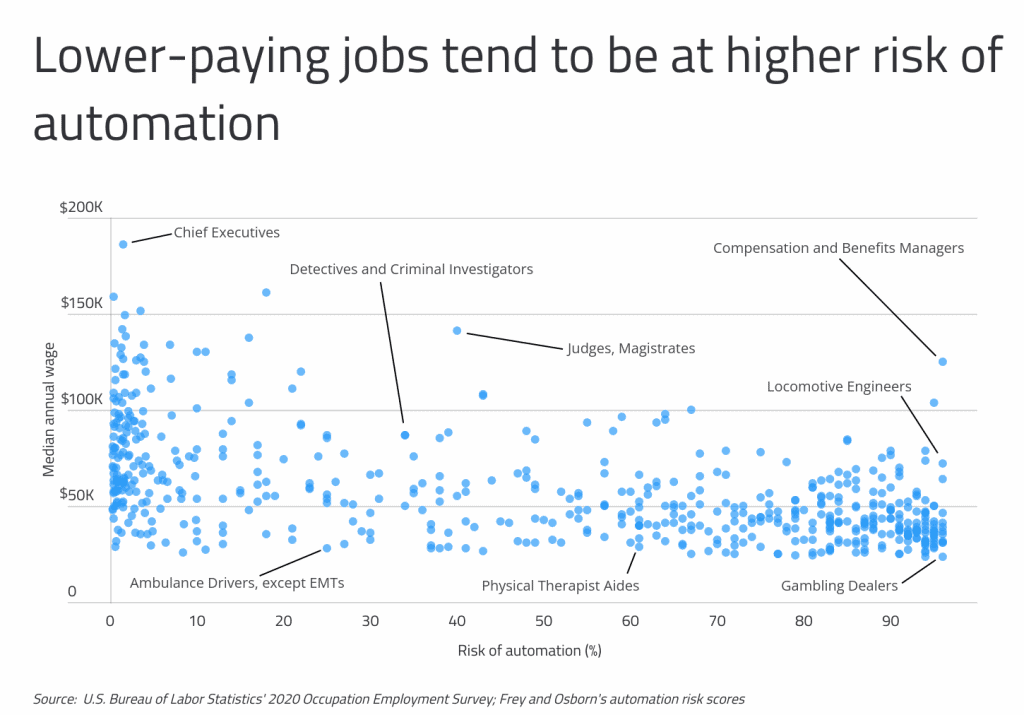[ad_1]
In the previous couple of years, it has develop into extra widespread to order meals from a kiosk, see machines cleansing airport flooring, and discuss to a chatbot as a substitute of a customer support agent.
The COVID-19 pandemic has accelerated the adoption of those applied sciences in addition to others, a lot of which can be utilized to carry out duties that people used to do. Machines don’t name out sick or unfold illness and might exchange employees to help in social distancing.
Whereas some jobs and duties, particularly people who require creativity and interpersonal expertise, aren’t conducive to automation, many others are. Based on knowledge from the Bureau of Labor Statistics and Oxford College, 42% of U.S. employees are at excessive threat of automation.
Decrease expert jobs, particularly people who contain repetition, usually tend to be automated. A Brookings study on automation’s affect on individuals finds that jobs in workplace administration, manufacturing, transportation, and meals preparation are probably the most vulnerable to automation.
These jobs are extra conducive to automation as a result of they contain both routine, bodily labor, or data assortment and processing actions. Usually some of these jobs are lower-paying, however some jobs at low threat of automation embrace low-paying private care and home service work.
Information from the Bureau of Labor Statistics mixed with automation threat knowledge from a University of Oxford study exhibits a correlation between the danger of automation and annual median wages. Playing Sellers, who’ve a chance of automation of 96%, earn a median annual wage of lower than $24,000. On the alternative finish of the spectrum, Chief Executives have only a 1.5% threat of automation and earn a median annual wage of $186,000. Most occupations fall someplace between these extremes.

Whereas automation will occur in every single place, its impacts will likely be felt extra closely in some elements of the nation than others resulting from native trade make-up and employee ability set. The Brookings automation research finds that rural communities are likely to have a a lot bigger share of duties which can be prone to automation than do extra populated areas.
On the state degree, Nevada and South Dakota have the very best share of employees at excessive threat of automation—outlined right here as occupations with automation dangers of 0.7 or larger — at 48.4% and 46.9%, respectively. Nevada is one in every of simply two states the place casino-style playing is authorized state-wide, and playing sellers are at a really excessive threat of automation.

RELATED
Learn concerning the good and unhealthy facets of Plus500, in addition to tips on how to open an account and begin buying and selling — when the buying and selling platform turns into obtainable in america — in our complete Plus500 review.
To find out the U.S. metropolitan areas with probably the most employees vulnerable to automation, researchers at Commodity.com analyzed the newest knowledge from the U.S. Bureau of Labor Statistics and the College of Oxford.
Researchers ranked metros based on the share of employees at excessive threat of automation, the full variety of employees at excessive threat of automation, the share of employees at medium threat of automation, and the share of employees at low threat of automation. To enhance relevance, solely metropolitan areas with at the least 100,000 individuals have been included within the evaluation.
Listed here are the metros with probably the most employees vulnerable to automation.

Massive Metros With the Most Staff at Threat of Automation

15. Los Angeles-Lengthy Seashore-Anaheim, CA
- Share of employees at excessive threat of automation: 42.6%
- Whole employees at excessive threat of automation: 1,644,440
- Share of employees at medium threat of automation: 19.4%
- Share of employees at low threat of automation: 38.0%
TRENDING
There are a number of methods to commerce commodities. Would you like possession over it? Do you wish to commerce bodily? Or on-line? Right here’s extra details about the fundamentals of buying and selling commodities and selecting commodity brokers.

14. Miami-Fort Lauderdale-West Palm Seashore, FL
- Share of employees at excessive threat of automation: 42.7%
- Whole employees at excessive threat of automation: 769,020
- Share of employees at medium threat of automation: 22.9%
- Share of employees at low threat of automation: 34.4%

13. Dallas-Fort Price-Arlington, TX
- Share of employees at excessive threat of automation: 42.8%
- Whole employees at excessive threat of automation: 1,046,720
- Share of employees at medium threat of automation: 21.5%
- Share of employees at low threat of automation: 35.6%

12. St. Louis, MO-IL
- Share of employees at excessive threat of automation: 43.1%
- Whole employees at excessive threat of automation: 383,540
- Share of employees at medium threat of automation: 19.4%
- Share of employees at low threat of automation: 37.5%

11. Jacksonville, FL
- Share of employees at excessive threat of automation: 43.2%
- Whole employees at excessive threat of automation: 205,280
- Share of employees at medium threat of automation: 22.3%
- Share of employees at low threat of automation: 34.5%

10. Birmingham-Hoover, AL
- Share of employees at excessive threat of automation: 43.4%
- Whole employees at excessive threat of automation: 155,150
- Share of employees at medium threat of automation: 20.8%
- Share of employees at low threat of automation: 35.9%

9. Nashville-Davidson–Murfreesboro–Franklin, TN
- Share of employees at excessive threat of automation: 43.4%
- Whole employees at excessive threat of automation: 289,600
- Share of employees at medium threat of automation: 19.6%
- Share of employees at low threat of automation: 37.0%

8. Orlando-Kissimmee-Sanford, FL
- Share of employees at excessive threat of automation: 44.0%
- Whole employees at excessive threat of automation: 361,400
- Share of employees at medium threat of automation: 23.3%
- Share of employees at low threat of automation: 32.6%

7. New Orleans-Metairie, LA
- Share of employees at excessive threat of automation: 44.3%
- Whole employees at excessive threat of automation: 158,550
- Share of employees at medium threat of automation: 19.5%
- Share of employees at low threat of automation: 36.2%

6. Indianapolis-Carmel-Anderson, IN
- Share of employees at excessive threat of automation: 44.6%
- Whole employees at excessive threat of automation: 309,530
- Share of employees at medium threat of automation: 20.4%
- Share of employees at low threat of automation: 35.0%

5. Grand Rapids-Wyoming, MI
- Share of employees at excessive threat of automation: 44.9%
- Whole employees at excessive threat of automation: 158,220
- Share of employees at medium threat of automation: 21.6%
- Share of employees at low threat of automation: 33.5%

4. Louisville/Jefferson County, KY-IN
- Share of employees at excessive threat of automation: 45.1%
- Whole employees at excessive threat of automation: 185,580
- Share of employees at medium threat of automation: 21.6%
- Share of employees at low threat of automation: 33.3%

3. Memphis, TN-MS-AR
- Share of employees at excessive threat of automation: 47.4%
- Whole employees at excessive threat of automation: 202,640
- Share of employees at medium threat of automation: 20.4%
- Share of employees at low threat of automation: 32.2%
DID YOU KNOW?
An important factor to contemplate when selecting a web-based dealer is whether or not it’s regulated by a reputable governmental company with actual enforcement powers. For a deep have a look at CFDs and CFD brokers, take a look at our CFD brokers information.

2. Riverside-San Bernardino-Ontario, CA
- Share of employees at excessive threat of automation: 48.8%
- Whole employees at excessive threat of automation: 476,660
- Share of employees at medium threat of automation: 20.1%
- Share of employees at low threat of automation: 31.1%

1. Las Vegas-Henderson-Paradise, NV
- Share of employees at excessive threat of automation: 49.3%
- Whole employees at excessive threat of automation: 307,650
- Share of employees at medium threat of automation: 22.7%
- Share of employees at low threat of automation: 28.0%
Detailed Findings & Methodology
To find out the U.S. metropolitan areas with probably the most employees vulnerable to automation, researchers at Commodity.com analyzed the newest knowledge from the U.S. Bureau of Labor Statistics’ Occupational Employment Survey and a College of Oxford research The Future of Employment: How Susceptible Are Jobs to Computerization?
Researchers ranked metros based on the share of employees at excessive threat of automation. Within the occasion of a tie, the metro with the upper share of employees at excessive threat of automation was ranked larger. Researchers additionally calculated the shares of employees at medium threat and low threat of automation.
Occupations at a excessive threat of automation are outlined as these jobs with dangers of automation of 0.7 and better. Occupations at medium threat of automation are outlined as jobs with automation dangers between 0.3 and 0.7, whereas occupations at low threat of automation are outlined as jobs with automation dangers lower than 0.3.
To enhance relevance, solely metropolitan areas with at the least 100,000 individuals have been included within the evaluation. Moreover, metro areas have been grouped into the next cohorts based mostly on inhabitants dimension:
- Small metros: 100,000-350,000
- Midsize metros: 350,000-1,000,000
- Massive metros: greater than 1,000,000
[ad_2]
Source link

